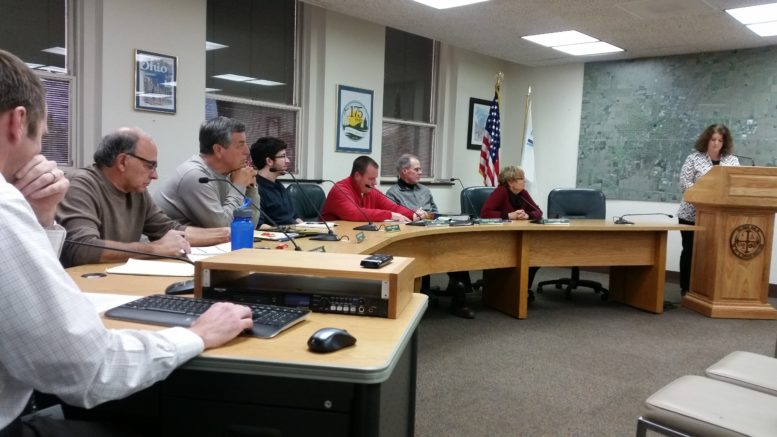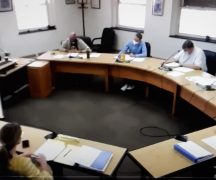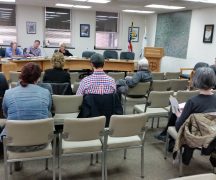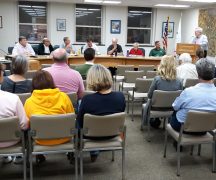By JAN LARSON McLAUGHLIN
BG Independent News
As members of Bowling Green City Council began their discussion on the city’s 2018 budget, it was fitting that Municipal Administrator Lori Tretter handed them “100 Grand” candy bars. There weren’t enough, so they had to share.
That was pretty much the theme of the evening.
The city projected a general fund deficit of $625,000 by the end of this year – primarily due to flat income tax revenues and continued cuts from the state. That deficit may be less than first projected, but will still be somewhere between $300,000 and $400,000.
So Tretter used another food analogy. This time a pizza.
“Perhaps you can think of all of the people who need to share the pizza,” she said to City Council. The pizza can be sliced many different ways. “But it’s still just one pizza we are sharing.”
Before City Council gets its hands on any of the $15 million budget, much of it has already been allocated for personnel costs, debt services and ongoing contracts. Close to 76 percent of the general fund goes for salaries and fringe benefits, which is a reasonable percentage, Tretter said.
So that leaves council with far less discretionary funds than their “wish lists” for the year. To get an idea of council members’ priorities, each was asked to identify areas they would like to see funded.
Council President Mike Aspacher started off the list with the Community Action Plan – an item that made every other council member’s list as well. “We’re all awaiting the final draft report of that study,” he said. The study is expected to suggest neighborhood revitalization efforts, East Wooster Street corridor work, and possibly a review of the city zoning code.
Aspacher predicted that City Council will probably be discussing some type of home maintenance policy, to monitor and control the condition of housing in the city. That may call for increased inspections or code enforcement changes.
While the first phase of the East Wooster Street corridor work will soon be underway with the roundabouts at Interstate 75, the city needs to start planning for the next phase of the project, Aspacher said.
Daniel Gordon stressed the need for the city to fund the CAP. “It does us no good to have a plan if we have no funds to implement it,” he said.
Sandy Rowland suggested that the city may have to look elsewhere for funding help. “The whole CAP program can’t be financed by the city alone,” she said, adding that investors and a community development foundation could assist.
In order for the Community Action Plan to work, Rowland said the city needs to update its zoning. “It’s obvious to me we can’t do anything without updating our zoning code,” she said. “We are where we are because of what is lacking in the zoning code.”
John Zanfardino asked for a definition of zoning code updates. Would they address aesthetics? Or the number of rentals allowed on one block? He expressed disappointment that the CAP did not address the existing housing stock in the city. He suggested a community development group could be created to help residents “flip houses.”
Zanfardino said the city needs more code enforcement personnel. “Code enforcement has to be beefed up,” he said.
Scott Seeliger agreed. “We can do all the zoning code updates,” but if the codes aren’t enforced, they are useless. He said an additional code enforcement position could possibly pay for itself with fines.
Bob McOmber also said a “comprehensive review” of the zoning codes is needed. “Is it a lack of personnel and enforcement, or a lack of appropriate legislation” that is the problem, he asked.
However, McOmber cautioned that Camiros, the consulting firm doing the CAP, estimated the cost of a zoning code update at $300,000.
“We’re talking about something quite major,” he said.
Rowland said she wasn’t suggesting the work be done by a consultant. But McOmber said that City Council doesn’t have the expertise, and Planning Director Heather Sayler doesn’t have the time.
Aspacher’s other priorities included considering more staff for the public works department, which saw the most staff cuts during the recession. “We ask more of them every year,” he said.
Many council members want to continue the 50/50 sidewalk replacement program, which splits the cost evenly between the city and the landowner. “We’re really starting to make some real progress,” Aspacher said.
Both Gordon and Rowland mentioned Complete Streets, with Gordon liking bike lanes, and Rowland supporting the Yay Bikes program which helps educate bicyclists and motorists in the city. According to Rowland, there is currently a “cold war” in the community between bicyclists and motorists who don’t like the idea of sharing the streets.
Rowland also mentioned the need for a larger city administration building, though added that it would not be a possibility for next year.
Zanfardino suggested that the city would have a little more money to spend on these priorities if it tweaked the request from the Convention and Visitors Bureau to increase the local hotel and motel tax. The CVB has asked that the tax be raised from 3 to 4 percent. Currently, the CVB gets 60 percent of the tax, and the city gets the other 40 percent. The CVB has asked to get the entire additional 1 percent. “I don’t mean to deny the CVB,” Zanfardino said, but the city could also put that money to good use if it was divided 60/40 like the existing 3 percent.
Seeliger brought up the need to address space issues at Oak Grove Cemetery. “We’re running out of room,” he said. “I think this is the year it needs to be done.”
McOmber, who is retiring from council at the end of the year, cautioned his fellow members that their wish lists were far more than the city could afford.
“It’s not like we’re going to be rolling in money,” he said. “Good luck. We’re talking about a pretty good size hill to climb – multiple hills.”
Mayor Dick Edwards was also asked to share his priorities for the year. He mentioned the need to work on historic preservation, especially near the county courthouse. “I see some of our historic homes continue to deteriorate,” he said.
As for the East Wooster improvements and CAP goals, the mayor said the city needs to take an incremental approach. “As long as we keep moving forward,” he said.





